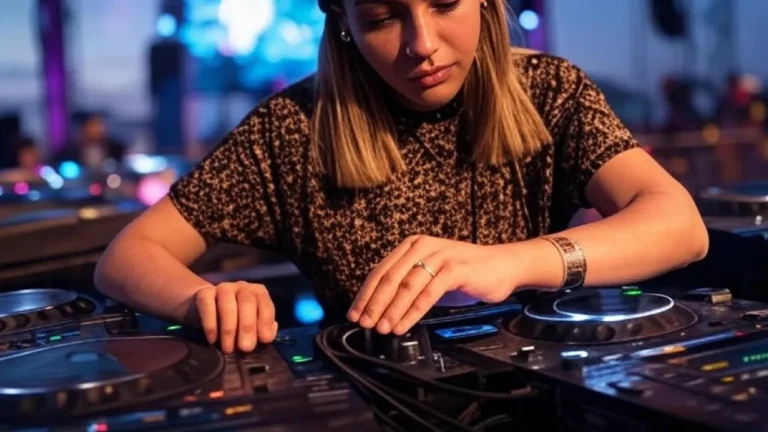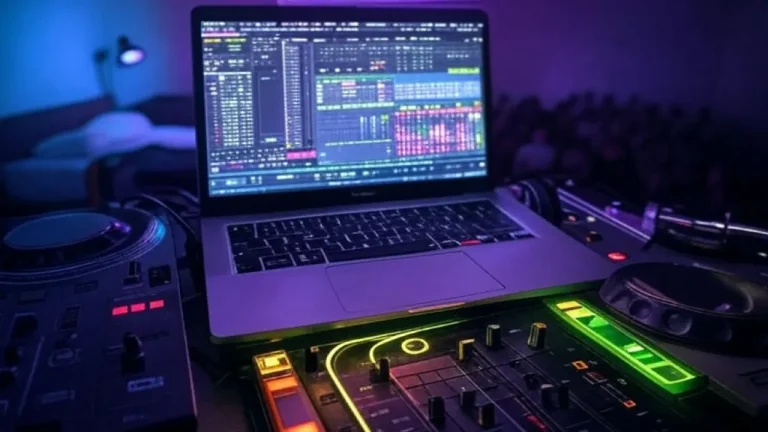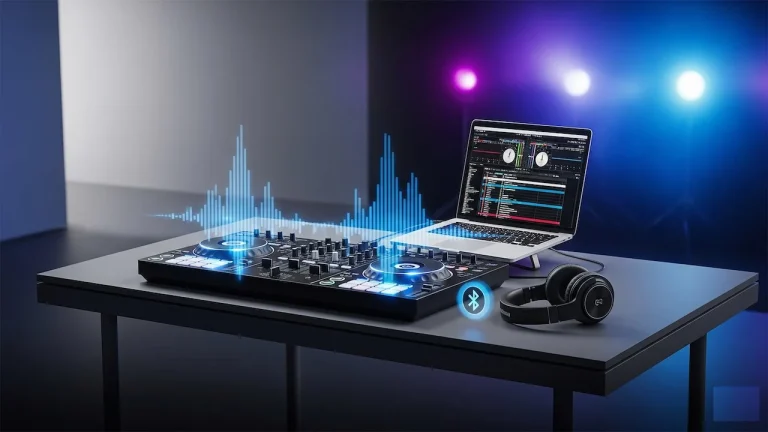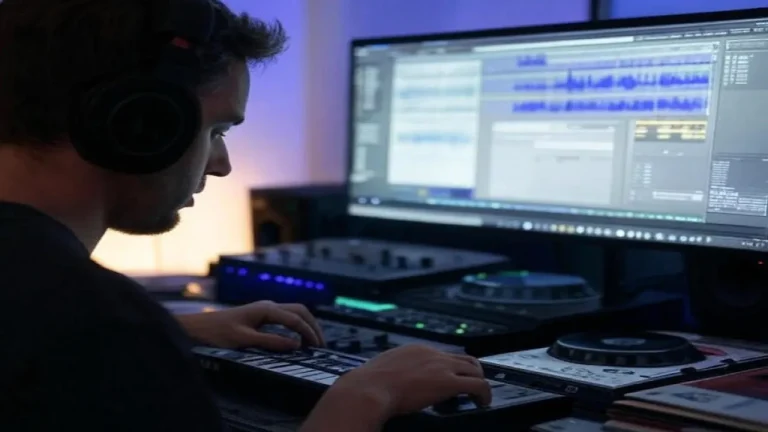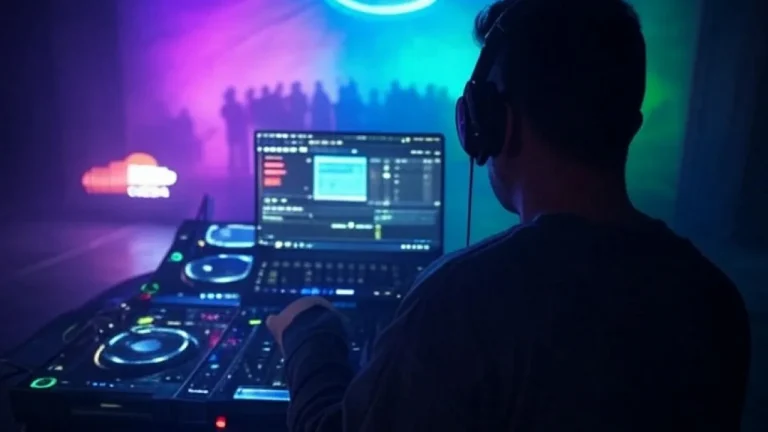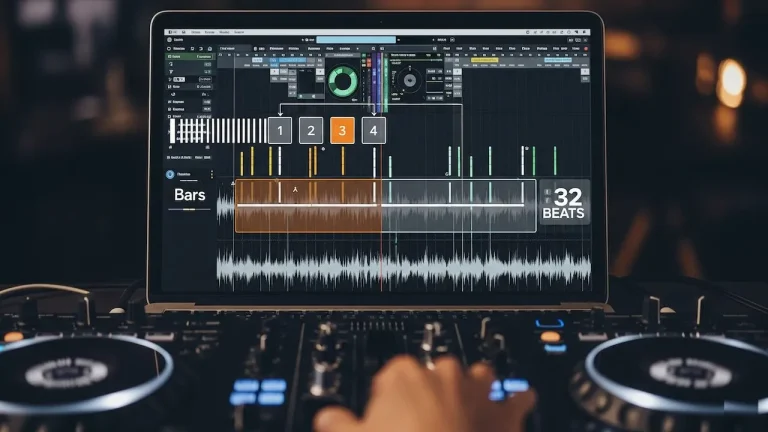Master Afrobeats and Amapiano mixing by understanding tempo matching between 100-130 BPM, using key harmonic mixing techniques, and applying proper crossfading methods. Top DJs like DJ Shinski and DJ TOPS create seamless blends featuring artists like Burna Boy, Asake, and Focalistic to produce globally trending mixes that captivate audiences worldwide.
What Makes Afrobeats and Amapiano Perfect for DJ Mixing
Both genres share complementary rhythmic structures that enable smooth blending. Afrobeats typically ranges from 100-120 BPM while Amapiano sits between 110-130 BPM. Professional DJs ensure tempo matching by aligning BPM values between tracks to maintain consistent groove throughout sets.
These genres feature similar percussion patterns and syncopated rhythms. Additionally, both styles emphasize strong basslines and repetitive melodic loops that create natural mixing points. Therefore, DJs can create extended blends without jarring tonal shifts.
| Genre | Typical BPM Range | Key Characteristics | Popular Artists |
|---|---|---|---|
| Afrobeats | 100-120 BPM | Syncopated drums, strong basslines | Burna Boy, Wizkid, Asake |
| Amapiano | 110-130 BPM | Log drums, jazzy chords, vocal chops | Focalistic, Uncle Waffles, Kabza De Small |
Master the Essential BPM and Tempo Matching Techniques
Start by checking BPM values and use pitch faders to match tempo between slower and faster tracks. Professional mixing requires precise timing adjustments to create seamless blends.
Use these proven tempo matching methods:
- Digital BPM sync: Enable sync functions on CDJs and controllers for automatic tempo alignment
- Manual pitch adjustment: Gradually adjust pitch faders while monitoring beat grids on displays
- Vinyl-style matching: Physically manipulate platters or jog wheels to align beats manually
- Half-time doubling: Match 60 BPM Amapiano with 120 BPM Afrobeats by counting every other beat
Plan energy progression by starting with lower BPM tracks and gradually increasing tempo intensity throughout your set. This approach creates dynamic listener experiences.
Advanced Tempo Change Techniques
Create dramatic set moments using tempo shifts between contrasting BPM ranges. Drop from fast Afrobeats into slower Amapiano sections using breakdown techniques. Similarly, build energy by layering percussion elements before tempo increases.
Practice these specific tempo change methods: echo effects during slowdowns, filter sweeps for buildups, and air horn samples at transition points. Each technique adds professional polish to genre switches.
Key Harmonic Mixing Strategies for Both Genres
Harmonic mixing prevents clashing melodies when blending Afrobeats and Amapiano tracks. Analyze track keys using software like Mixed in Key or Serato DJ’s key detection features.
Apply the Circle of Fifths principle for smooth key transitions:
- Same key mixing: Blend tracks in identical keys (like C major to C major)
- Relative key mixing: Move between major and minor versions (C major to A minor)
- Perfect fifth transitions: Jump five semitones up or down the circle
- Camelot wheel method: Use adjacent numbers or same numbers with different letters
| Key Transition Type | Example | Mixing Difficulty | Best Use Case |
|---|---|---|---|
| Same Key | A major to A major | Easy | Long blends, extended mixes |
| Perfect Fifth | C major to G major | Medium | Energy building, chorus drops |
| Relative Minor | F major to D minor | Easy | Mood changes, breakdown sections |
| Diminished Fifth | C major to F# major | Hard | Dramatic drops, surprise elements |
Equipment Setup for Professional Afrobeats Amapiano Mixing
Choose DJ software that handles African music production styles effectively. Serato DJ Pro, Virtual DJ, and rekordbox all offer robust BPM detection for complex polyrhythmic patterns found in both genres.
Hardware recommendations for optimal performance:
- Pioneer CDJ-3000: Industry standard with precise hot cue functions and beat jump capabilities
- Denon DJ SC6000M: Advanced processing power for real-time stem separation and effects
- Allen & Heath Xone:96: Analog warmth perfect for Amapiano’s organic sound textures
- Native Instruments Traktor S4 MK3: Haptic jog wheels ideal for Afrobeats scratch techniques
Audio Interface and Monitor Setup
Invest in quality audio interfaces that preserve the dynamic range of African production styles. Focusrite Scarlett 18i20 or RME Babyface Pro FS deliver pristine sound reproduction for professional mixing.
Monitor selection impacts mix quality significantly. KRK Rokit 8 G4 speakers provide accurate bass response for Amapiano’s deep low-end frequencies. Alternatively, Pioneer HDJ-X10 headphones offer precise cue monitoring for beatmatching accuracy.
Creative Mixing Techniques and Effects Application
Layer percussion elements from different tracks to create unique rhythm combinations. Isolate drum patterns using EQ kills, then gradually introduce complementary elements from incoming tracks.
Master these creative mixing approaches:
- Acapella layering: Extract vocals from Afrobeats tracks over Amapiano instrumentals
- Drum replacement: Substitute Amapiano log drums with Afrobeats percussion patterns
- Melodic looping: Extend catchy hooks using loop rolls and beat repeats
- Filter automation: Create tension using high-pass and low-pass filter sweeps
Effects Processing for Genre Blending
Apply reverb and delay effects to create space between conflicting musical elements. Short reverb tails on percussion help blend different drum programming styles. Meanwhile, longer delays on melodic elements create atmospheric bridges between songs.
Use these effects combinations: chorus on basslines for width, phaser on hi-hats for movement, and bit crusher on vocal chops for texture variation. Each effect enhances the organic fusion between electronic Amapiano and traditional Afrobeats elements.
Building Dynamic Set Structures and Energy Flow
Construct sets that showcase both genres’ unique characteristics while maintaining dancefloor engagement. Start with mid-tempo Afrobeats around 110 BPM, then introduce Amapiano elements gradually through the mix.
Follow this proven set structure template:
- Opening (15 minutes): Classic Afrobeats at moderate tempo to establish groove foundation
- Building (20 minutes): Introduce Amapiano percussion while maintaining Afrobeats melodies
- Peak time (25 minutes): Full Amapiano bangers with highest energy and crowd participation
- Breakdown (10 minutes): Strip back to Afrobeats vocals over minimal Amapiano backing
- Closing (10 minutes): Blend both genres for memorable finale with signature tracks
Reading Crowd Response and Adapting
Monitor dancefloor energy through visual cues and audience participation levels. When crowds respond positively to specific genre blends, extend those sections using loop functions and creative layering techniques.
Adapt your approach based on venue atmosphere. Corporate events favor smoother Afrobeats transitions, while club environments welcome aggressive Amapiano drops and creative scratching techniques.
Track Selection and Library Organization
Organize your music library using consistent tagging systems that identify BPM, key, energy level, and mixing compatibility ratings. Create smart playlists that automatically group tracks by these criteria for quick access during live sets.
Essential track categories for comprehensive Afrobeats Amapiano mixing:
- Intro tracks: Moderate BPM songs with clear 32-bar structures perfect for opening sets
- Peak time bangers: High-energy tracks with strong hooks and crowd-pleasing choruses
- Transition tools: Instrumental versions and acapellas for creative mixing opportunities
- Wild cards: Unexpected genre fusions and remixes that surprise audiences
| Track Category | BPM Range | Key Characteristics | Set Placement |
|---|---|---|---|
| Intro Tracks | 100-115 BPM | Clear structure, moderate energy | Opening 15 minutes |
| Peak Bangers | 120-130 BPM | High energy, crowd favorites | Middle 25 minutes |
| Breakdown Tools | 105-120 BPM | Stripped arrangements | Energy transitions |
| Wild Cards | Varies | Genre fusion, surprises | Peak moments only |
Performance Tips and Stage Presence
Develop confident stage presence that matches the vibrant energy of African music culture. Use hand gestures and body movement to emphasize rhythm changes and build crowd connection during performance.
Master these performance enhancement techniques:
- Microphone skills: Practice call-and-response patterns common in Afrobeats culture
- Visual engagement: Maintain eye contact with audiences during key mixing moments
- Energy matching: Mirror the enthusiasm level of your track selections through physical movement
- Timing awareness: Know when to step back and let the music speak versus adding personal flair
Handling Technical Difficulties
Prepare backup solutions for common technical issues during live performances. Keep emergency playlists loaded on multiple devices and practice mixing without visual waveforms to maintain professionalism.
Always carry essential backup equipment: spare USB drives with duplicate libraries, emergency headphones, and analog audio cables for direct connections. Professional DJs anticipate problems and solve them invisibly.
People Also Ask
Mix Afrobeats and Amapiano between 110-120 BPM for optimal compatibility. This sweet spot allows natural blending without extreme tempo adjustments. Most professional DJs work within 120-150 BPM ranges for maximum dancefloor impact.
Yes, basic DJ software like VirtualDJ or free options like Mixxx handle Afrobeats Amapiano mixing effectively. However, professional software offers better key detection and advanced effects for creative blending opportunities.
Use harmonic mixing principles and match track keys using the Circle of Fifths method. Additionally, practice EQ isolation techniques to remove conflicting frequency ranges during blends.
Pioneer CDJ-3000 players with Allen & Heath mixers provide industry-standard performance capabilities. Many successful African music DJs also use Serato DJ Pro software for reliable track analysis and effects processing.
Basic scratching techniques enhance Afrobeats mixing but aren’t required for Amapiano. Focus on clean blending and harmonic mixing first, then add scratch elements as creative flourishes during appropriate moments.
Expect 6-12 months of consistent practice to develop competent mixing skills. However, mastering the cultural nuances and advanced techniques for both genres typically requires 2-3 years of dedicated learning and performance experience.
Amapiano features log drums and jazz-influenced chords while Afrobeats emphasizes syncopated percussion and melodic vocals. Both genres share similar BPM ranges but have distinct production characteristics that require different mixing approaches.
Yes, these genres are globally popular and create lucrative performance opportunities. Specialized African music DJs command premium rates at cultural events, festivals, and club residencies worldwide.


